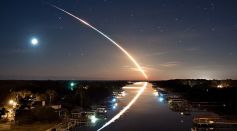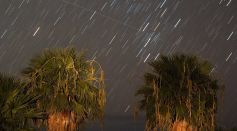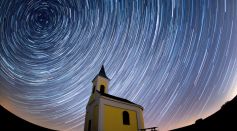Tags: Meteor Shower

Meteoroid Fireball Flies Over Mishawaka, Nearby Communities Ahead of Orionids Meteor Shower [WATCH]
When, Where Is The Best Time And Location For Orionids Meteor Shower Best Viewing Experience?

Orionid Meteor Shower, Full Hunter's Moon 2021 Happening This Week: How To Watch

Melon-Sized Meteorite Crashes Through a Woman's Roof in Canada; What are the Odds of Getting Hit By a Space Rock?

October Meteor Showers: How To Watch Draconids, Orionids Peak This Month

Taurids Complex: Swarm of Large Near-Earth Asteroids Linked to a Comet Breakup 20,000 Years Ago

October 2021 Astronomical Events: Don’t Forget To See Moon, Mercury, Meteor Shower This Month

Orionids Meteor Shower 2021: How and When to Watch 20 Shooting Stars Per Hour on October

Perseid Meteors Wow NASA's All-Sky Fireball Network After Blazing Through Night Sky [WATCH]

Delta Aquariids 2021: How to Watch This Week’s Meteor Shower
Don't Miss Perseid Meteor Shower This Year! Will It Produce Up to 100 Meteors an Hour this August?

Weird 4,000-Year-Old Comet Cause Meteor Showers Detected by Scientists

Eta Aquarids May 2021: Meteor Shower to Illuminate the Sky With Shooting Stars

Lyrid Meteor Shower 2021: Will It Dazzle Skies This Month?

Astronomy 2021: Your Guide to The Full Moons, Eclipses And Meteor Showers This Year!

First Meteor Shower Forecasted in 2021; Here's How To Watch It
Penumbral Eclipse, Leonid Meteor Shower, and More: November Sky Events To Watch Out For
How to See the Draconid Meteor Shower on October 7
![[WATCH]: Fireball Caught on Camera in Northeast Ohio Skies](https://d.sciencetimes.com/en/full/29767/watch-fireball-caught-camera-northeast-ohio-skies.jpg?w=237&h=131&f=dad4a04efb249f0f520d90a25412d15b)
[WATCH] Fireball Caught on Camera in Northeast Ohio Skies

The Perseid Meteor Shower's Peak Is Just Days Away!
Most Popular

10 Weird Things the Human Body Does—and the Science Behind These Biological Mysteries

Top Space Technology Trends and Aerospace Innovations Revolutionizing the World Today

Why Mega Typhoons Keep Getting Stronger: The Science Behind Typhoon Formation and Extreme Weather

How Plate Tectonics Trigger Earth's Most Dangerous Disasters Through Powerful Seismic Hazards





